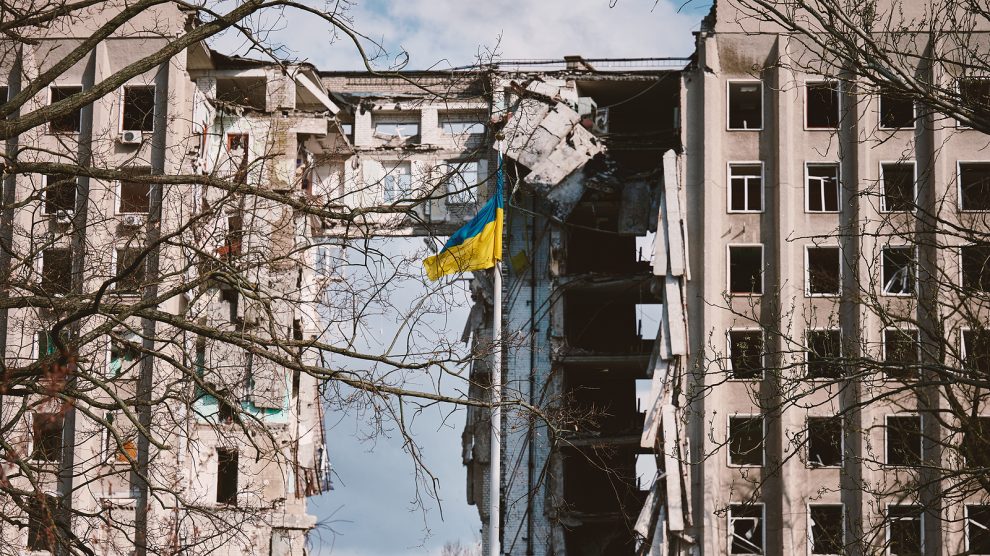With the latest US aid package for Ukraine stuck in the House of Representatives, a new report reveals the growing cost of recovery and reconstruction.
Russia’s war on Ukraine—which began two years ago next week—has now caused 152 billion US dollars in direct damage to buildings and infrastructure, a major new report claims.
The most affected sector is housing (almost 56 billion US dollars, or 37 per cent of total damage). Across the country, 10 per cent of the housing stock has been damaged or destroyed, prolonging the displacement of Ukrainians from their communities.
Other sectors impacted include transport (almost 34 billion US dollars, or 22 per cent), commerce and industry (almost 16 billion US dollars, or 10 per cent), energy (almost 11 billion US dollars, or seven per cent), and agriculture (10 billion US dollars, or seven per cent).
- Moldova, Ukraine set standard for Eastern Partnership countries
- Russia’s war on Ukraine: Five essential reads
- On the brink of extinction, Ukraine’s lonely bison are looking for love
The figures were made public on February 15 with the publication of the World Bank’s latest Ukraine Damage and Needs Assessment, the third such report —undertaken jointly with the government of Ukraine, the European Commission, and the United Nations and supported by other partners—which takes stock of almost two years of the war, estimating damage and losses along with recovery and reconstruction needs for 10 years.
“The last two years have seen unprecedented suffering and loss for Ukraine and its people,” says Antonella Bassani, World Bank Vice President for Europe and Central Asia. “Yet, while this updated assessment documents the extensive damages and consequent needs, it is at the same time a testament to Ukraine’s resilience—demonstrating that the dedication and adaptability of its people have helped to already repair some of the damage and build towards recovery”
The cost of reconstruction
The report shows that as of December 31, 2023, recovery and reconstruction needs are estimated at almost 486 billion US dollars considering an (ambitious) 10-year period to meet them.
These needs include critical steps for short-term recovery as well as medium-term reconstruction that builds back better to modern, low-carbon, and climate-resilient standards, and that—where relevant and possible—excludes needs already met through the Ukraine state budget or through partners and international support.
In 2024 alone, Ukrainian authorities estimate the country will need around 15 billion US dollars for immediate reconstruction and recovery priorities at both the national and community level, with a particular focus on supporting and mobilising the private sector alongside restoration of housing, soft infrastructure and services, energy, and transport.
The report, which comes amid an ongoing row in the US that has seen Washington’s latest aid package for Ukraine held up in the House of Representatives, highlights that while some 5.5 billion US dollars of this funding has been secured, from both Ukraine’s international partners and its own resources, about 9.5 billion US dollars is currently unfunded.
Ukraine’s prime minister, Denis Shmyhal, believes that frozen Russian assets should be used to close the funding gap.
“We see that the needs for reconstruction have continued to grow over the past year,” he says. “The main resource for Ukraine’s recovery should be the confiscation of Russian assets frozen in the West. We need to start this process already this year. Concurrently, the Ukrainian government is creating conditions to attract private investments, which will accelerate the reconstruction process and transform our country on its path to the EU.”
Courage and committment
The report’s findings complement the priorities foreseen in reform and investment agenda of the Ukraine Plan that will lay the framework for implementing payments under the Ukraine Facility for the next four years by the EU.
As Ukraine prepares for the EU accession process, these reforms and investments support the principles of “building back better” and the institutional capacity of national and subnational authorities.
Since the last Damage and Needs Assessment, the government of Ukraine, with the support of its partners, has met some of the most urgent needs. For example, in the housing sector, according to government of Ukraine data, in 2023, one billion US dollars was disbursed toward housing sector recovery, with most being dedicated to the repair and reconstruction of damaged buildings.
In the transport sector, more than 2,000km of emergency repairs were made on motorways, highways, and other national roads. In the education sector, local authorities rebuilt approximately 500 educational institutions and since January 2023, the share of educational institutions with bomb shelters has increased from 68 per cent to 80 per cent.
The latest Damage and Needs Assessment also includes stronger data and analysis of the impact on vulnerable groups of people and on communities. It presents the case for investment in Ukraine’s human capital.
“The war is not over. The suffering is not over,” says Denise Brown, United Nations Resident Coordinator in Ukraine.
“But communities in Ukraine are demonstrating significant courage and commitment in driving their own inclusive recovery processes and they need the continued support of their international partners. The future of Ukraine depends upon the people of Ukraine; this is where we need to invest.”
Unlike many news and information platforms, Emerging Europe is free to read, and always will be. There is no paywall here. We are independent, not affiliated with nor representing any political party or business organisation. We want the very best for emerging Europe, nothing more, nothing less. Your support will help us continue to spread the word about this amazing region.
You can contribute here. Thank you.







Add Comment